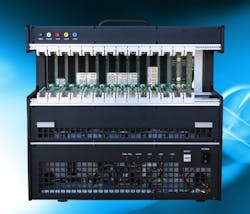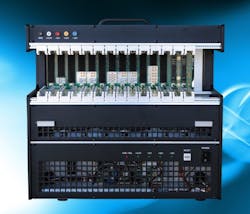Elma debuts 3U OpenVPX test platform to speed board development for C4ISR convergence
FREMONT, Calif.– Elma Electronic in Fremont, California, is introducing its 3U OpenVPX Convergence Development Platform as a test environment to facilitate the integrated development of common, modular hardware architectures across critical C4ISR and electronic warfare (EW) systems. The new system is designed to help optimize technology reuse across U.S. Department of Defense (DOD) programs and to support rapidly developing activities begun under the Command, Control, Communications, Computers, Intelligence, Surveillance and Reconnaissance (C4ISR) Modular Open Suite of Standards (CMOSS) initiative.
The U.S. Army Material Command (Research, Development and Engineering Command) Communications-Electronics Center (CERDEC) leads CMOSS, which is intended to move the embedded industry away from costly, complex, proprietary solutions and toward readily available, cost-effective, and open-architecture commercial off-the-shelf (COTS) technologies.
Elma’s new development platform is designed to enable system engineers to test a range of boards that meet profiles designed to meet various DOD program requirements, streamlining engineering efforts and reducing time and cost to deployment, officials say. The 3U OpenVPX Convergence Development Platform is built on the company’s easy-access E-frame test chassis and features a 12-slot 3U OpenVPX backplane providing 10GBase-KR board-to-board signaling with aggregated port speeds to 40G. The chassis accommodates boards with the latest VITA 65.0-2017 slot profiles for target application development, and supports conduction-cooled cards with open access for test.
“The military’s shift towards modular, open standards-based hardware and software is fueling the need for reliable methods to quickly test hardware components across different platforms,” explains Ken Grob, director of embedded computing business development at Elma. “This new development kit enables system developers to cost-effectively test and validate a wide number of hardware configurations.”
Initially, separate program efforts were undertaken by the U.S. Army CERDEC with CMOSS, the U.S. Navy Naval Air Systems Command (NAVAIR) with Hardware Open Systems Technology (HOST), and the U.S. Air Force’s Air Force Life Cycle Management Center (AFLCMC) with Sensor Open Systems Architecture (SOSA) to move away from costly proprietary systems to COTS-based open standards.
Each initiative was created to facilitate the development of interoperable systems across several defense branches to improve subsystem size, weight, and power (SWaP), enable rapid technology insertion, and promote reuse. Now managed entirely under SOSA, this collection of open architecture hardware and software standards is aimed at providing reconfigurable, upgradeable, and cost-effective C4ISR capabilities in deployed platforms across sensor applications throughout all major military branches.
One of the tasks of the SOSA and HOST working groups is to define 3U and 6U slot profiles required to build OpenVPX-based subsystems for the tri-service convergence initiative. The first series of profiles was developed and submitted for inclusion in the VITA 65.0-2017 specification. Additional 3U and 6U profiles are being developed to take advantage of the new VITA 67.3 connectors to meet the needs of signals intelligence (SIGINT), EW, and software-defined radio (SDR) system requirements.
Using this set of profiles, Elma’s Convergence Development Platform is ideal for developing C4ISR systems used in ground vehicles, unmanned systems, command centers, and other mission-critical environments. The heart of the platform is a 3U 12-slot OpenVPX backplane that meets VITA 65.0-2017 backplane profile BKP3-TIM12-15.3.6-n. It supports all the SOSA-developed VPX slot profiles, with aperture installation options for high-speed radio frequency (RF) under VITA 67.3 and optical input/output (I/O).
The boards included for development also meet the new profiles: two single-board computers (SBCs), one with an Intel Core i7 processor and one using an Intel Xeon processor, as well as a 10/40 Gigabit Ethernet (GigE) switch. A network timing slot provides IEEE 1588 radial support for precision network timing and synchronization, with timing card options available.
Elma’s Type 39 E-Frame chassis provides open access for easy board testing and troubleshooting. It supports both air- and conduction-cooled board configurations. Dual, high-wattage 3U VPX pluggable power supply units are also included.
The modular, building block design of the backplane streamlines a path to the required configuration. End users can identify a subset of the slot profiles they will need for a cost-effective backplane suited to the end application.
Pricing and delivery for the development platform is dependent upon configuration.
Elma Electronic Inc. is a global manufacturer of commercial, industrial and rugged electronic products for embedded systems and application-ready platforms – from components, storage boards, backplanes, chassis, and enclosures to fully integrated subsystems.
With one of the widest product ranges available in the embedded industry, Elma also offers standard and custom cabinets and enclosures as well as precision components such as rotary switches/encoders, LEDs, front panels, and small cases.
Elma leverages proven technology based on VITA, PICMG, and other standards-based architectures (i.e., OpenVPX, VME, CompactPCI Serial, ATCA, MicroTCA, COM Express, and PCIe/104). Elma is also actively engaged in designing solutions for applications requiring smaller footprints, officials say.
Elma Electronic manages entire projects from initial system architecture to specification, design, manufacturing and test through its worldwide production facilities and sales offices. The company serves the mil/aero, industrial, research, telecom, medical, and commercial markets and is certified to ISO 9001 and AS 9100.
With U.S. headquarters in Fremont, Calif., the company maintains multiple sales, engineering, and manufacturing operations in Atlanta, Ga., and Philadelphia, Pa.

